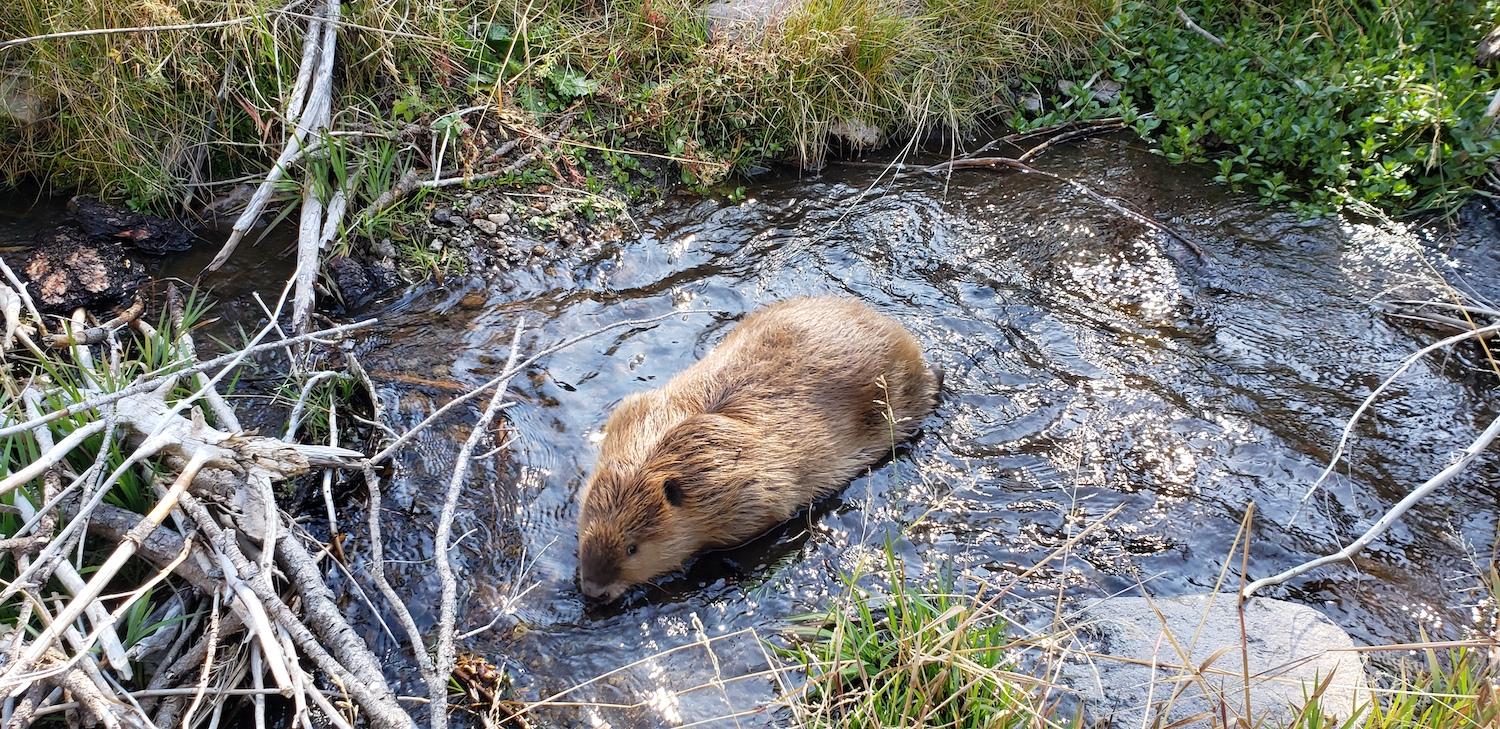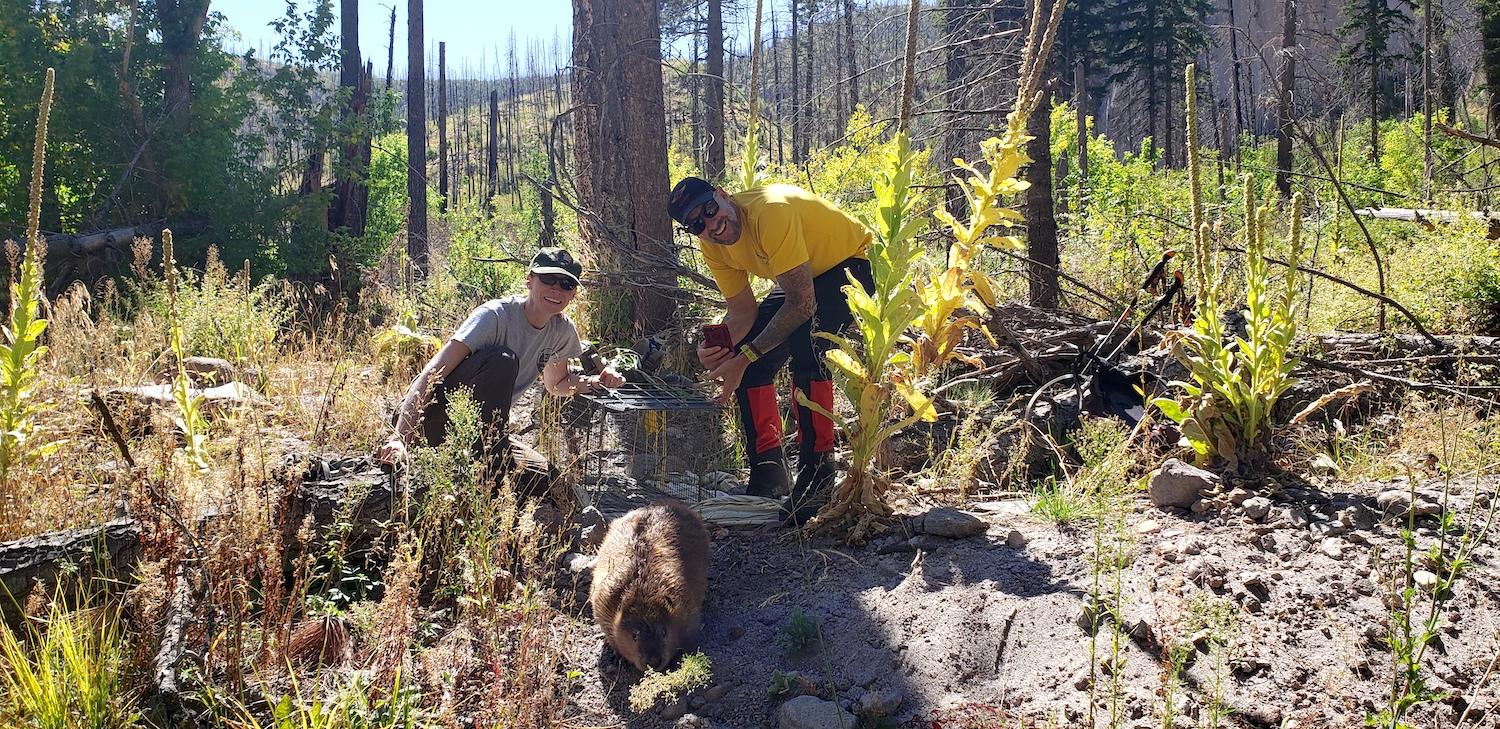
Beavers are working to restore Bandelier National Monument's Frijoles River watershed/NPS
Under the Willows | Beavers Return To Bandelier National Monument
By Patrick Cone
BANDELIER NATIONAL MONUMENT -- Bandelier National Monument has had its share of natural disasters. In 2011 the Las Conchas fire burned 156,000 acres in northern New Mexico, much of it at Bandelier. And then, two years later, a devastating flood, the largest in recorded history, coursed down its narrow canyons. The landscape was drastically changed, from Ponderosa pine forests to rocky mesas and log-jam choked canyons. Nearly three quarters of the Frijoles Canyon’s upper watershed’s forest was destroyed.
But when there is destruction, there is also rebirth and an opportunity for restoring the landscape, by recovering native fish species and the industrious beavers, known as a keystone species. They’re nature’s preeminent dam builders. Their keenly assembled piles of wood create ponds that support wildlife, aquatic species, and even act as natural firebreaks. They also slow stream flows, holding back precious water in this rugged desert landscape.
After decades of them being hunted and killed because they were flooding landscapes, cutting down trees and making travel in the narrow canyons difficult, beavers have made a comeback. In 2019 four beavers were introduced above the Upper Falls by the National Park Service. Since then, 27 beavers have been brought into the park and released. But the idea wasn’t a new one.
As far back as 1938 there was talk about bringing more beavers back. W.B. McDougall wrote in Southwestern Monuments Monthly Reports, “Beavers are present in the canyon below headquarters. This part of the canyon contains numerous narrow-leaved cottonwood trees which furnish a suitable food supply for the beaver. Numerous trees have been cut, especially near the monument boundary, and there are several dams.”
McDougall saw very few aspens between headquarters and the Rio Grande River, however, and wrote,” I do not believe beaver would stay in this part of the canyon if they were introduced because of this lack of a food supply.” But he was told that there were aspen groves at the head of the drainages that might support them.
Today in Frijoles Canyon, pond after pond reveals their presence. Dense stands of willow show the telltale clipping of sharp teeth, and there are chisel-like marks on tree stumps. But it hasn’t been an easy process.

Along the Frijoles River the beavers have built a series of dams/Patrick Cone
Sarah Milligan, the natural resources program manager at Bandelier, and describes how the program came about. “We started working with New Mexico Department of Game and Fish in 2018 to relocate problem beavers to prevent them from being euthanized,” she says. And, in a build-it-and-they-will-come scenario, the rangers constructed artificial habitats, called beaver dam analogs (BDAs), for them. They also planted native willows, an essential food source, which have thrived. And beavers are masters at managing willow stands, ensuring a stable supply.
And Milligan recognizes that the beaver can create a place for other species to thrive.
“We are hoping they can establish themselves to provide habitat for our native but endangered New Mexico Meadow Jumping Mouse and native leopard frogs," she said. "We also reintroduced native Rio Grande Cutthroat Trout in 2018 (and every year since) and they love using beaver ponds.”
But, two years later they weren’t able to find any of the four animals they relocated. “We did lose two of them, one to a mountain lion, and one we didn’t know what happened,” said Milligan. And there’s no easy way to track the animals, as radio telemetry would entail drilling into their tails, which is not something the rangers wanted to do.
But the rangers have persisted. Priscilla Hare is a biological services technician, and describes how the largest rodents in North America, which are trapped in the Taos area, are set loose in the monument.

Beavers are brought down to Bandelier from the Taos area/NPS
The beaver, ranging from 40 to 70 pounds, are left in their cages, and strapped to a frame pack, covered with a white blanket to reduce stress, and hiked high up the canyon to be released. “I do prefer the lighter beavers,” says Hare, laughing.
But even with such care, it’s very stressful for the animals, and not all of them survive. “Everyone wants to stop us and take a picture of the rangers with a frame on our backs. Someone asked once if I was carrying a bear,” she says.
Once released, the beavers do what beavers do. They are natural builders after all. They build and maintain their dams, using sticks and logs and mud, and even small rocks. “During fall they focus on gathering food for the winter,” says Hare as she gave us a tour of the dams, “because it’s harder for them to move around on snow; they’re swimmers, not walkers. They’ll collect a food source and actually stick it into the pond, so their food source is underwater and they can access it that way.”
And the benefits of their work are many, she says.
“They create oases, pooled water for tons of different wildlife. During climate change in dry years the ponds remain wet, though creeks start to dry up late summer. They like to have pooled water to hang out in. The beaver ponds don’t freeze over all the way,” said Hare. And streamside burrows, lodges, and ponds are safe places for them, away from predators.
Two game cameras do keep an eye on some of them, since it’s tough to observe them, as they work mostly at night or during twilight. “We’re not out here to watch them,” says Hare. Besides beavers, the cameras often show other wildlife utilizing the ponds, even capturing a bear taking a swim. While the game cameras keep track of their movements, a live cam might be in their future.

Brought into Frijoles Canyon on backpacks, the beavers soon find themselves a new home/NPS
Their ponds have also been an ideal place to reintroduce native fish.
“The fires and floods that came through in 2011 and 2013 wiped out all of the fish, and we used that as a place to start from,” says Hare. “We only introduce native fish to the area. The first fish were introduced in 2018; the Rio Grande cutthroat trout. This year (2022) we brought Rio Grande chub and Rio Grande sucker, and used the beaver ponds to introduce them into.”
And as the beavers multiply, they’re starting to repopulate these canyons, supporting not just themselves, but every bird, fish, bear, deer, invertebrates and vegetation that rely upon them. In Bandelier (and many other parks) they’ve been transformed from a nuisance, to a solution.
Coverage of science topics across the National Park System is made possible in part through support from Earthjustice.

 Support Essential Coverage of Essential Places
Support Essential Coverage of Essential Places
Comments
I really enjoyed Bandelier in 2016. One of the few nat'l monuments with camping. Haven't personally seen the damage from the fire or the floods, but change is the only constant, and the beavers will do what they do.
The creek was flowing and the access to the ruins was fascinating.
Great place to visit.